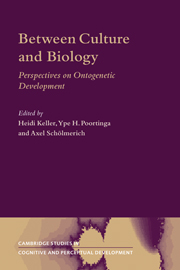Book contents
- Frontmatter
- Contents
- List of figures
- List of tables
- Notes on contributors
- Acknowledgements
- Introduction
- Part I Setting the scene
- Part II Perspectives on development informed by culture
- Part III Perspectives on development drawing from the universal and the specific
- Part IV Perspectives on development informed by evolutionary thinking
- Part V Metaperspectives
- Author index
- Subject index
- Cambridge Cultural Social Studies
Introduction
Published online by Cambridge University Press: 22 September 2009
- Frontmatter
- Contents
- List of figures
- List of tables
- Notes on contributors
- Acknowledgements
- Introduction
- Part I Setting the scene
- Part II Perspectives on development informed by culture
- Part III Perspectives on development drawing from the universal and the specific
- Part IV Perspectives on development informed by evolutionary thinking
- Part V Metaperspectives
- Author index
- Subject index
- Cambridge Cultural Social Studies
Summary
This book deals with various facets of the long-standing discussion about the relationship between biology and culture, with particular emphasis on how this relationship manifests itself (and maybe changes) during the course of ontogenetic development. The interaction between nature and nurture has fascinated scholars since the beginnings of academic psychology. Developmentalists such as Preyer (1882) in Germany and Carmichael (1925) in the USA, or personologists such as William Stern (1900/1994) have conceptualized these interactions as crucial in their psychological theorizing. Moreover, these views impress by their modernity in stressing the inseparability of the two aspects and their mutual interdependence.
Astonishingly, this early wisdom was hardly built upon in the following decades, during which theorists were devoted either to moulding psychology into a S–R (stimulus–response) framework in which there was no place for more encompassing interactions between organism and environment, or to the promotion of viewpoints of behaviour as almost infinitely pliable, pre-empting the need even to consider such interactions. During this period views on the relationship between culture and biology were primed by both implicit and often explicit views of mutual exclusivity of the physical and the mental or social domain, as if they were separate entities. In this process, much of culture and much of biology disappeared in favour of a trait-oriented understanding of human psychological functioning. Cognitive, emotional and motivational processes tended to be researched in isolation.
- Type
- Chapter
- Information
- Between Culture and BiologyPerspectives on Ontogenetic Development, pp. 1 - 10Publisher: Cambridge University PressPrint publication year: 2002
- 1
- Cited by

